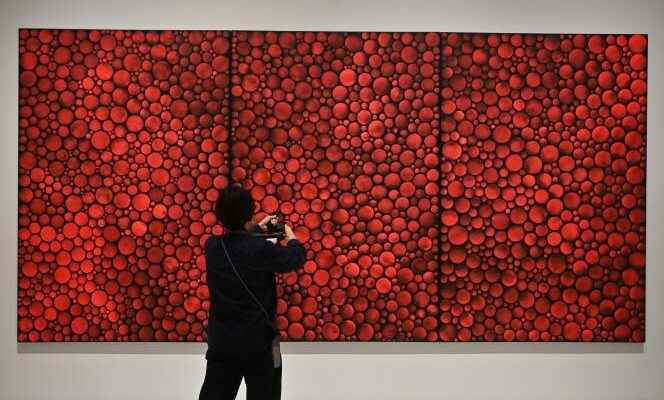At the opening of the retrospective “Yayoi Kusama, 1945 to the present” on November 12, the first visitors competed for the best angle, in the atrium of M+, to take selfies in front of two huge pumpkins with black polka dots acquired for the occasion. This classic, tirelessly declined and eminently Instagrammable, has become one of the Japanese artist’s hallmarks, in the same way as her other favorite motif, omnipresent, either on her outfits or on her paintings: the white polka dot on a red background, which recalls, consciously or not, the elegant and psychotropic fly agaric.
At 93, identifiable among all by his famous vermilion red wig, half-Cleopatra for the style, half-Bozo the clown for the color, Yayoi Kusama is undoubtedly the most recognized contemporary artist, literally, in Hong Kong. This is also where his works reached record prices. One of his pumpkinsin particular, made in 2010, sold for 5.8 million dollars in 2019 (5.4 million euros).
Yayoi Kusama is, by virtue of her notoriety alone, an ideal programming choice to mark the first anniversary of M+, the new Asian contemporary art museum, opening in November 2021. M+ has the role, with the support of a few others new institutions, to raise Hong Kong to the rank of regional cultural capital. The artist was unable to make the trip in person, but there were many exchanges between the two curators of the exhibition, Mika Yoshitake and Doryun Chong, and the artist’s studio in Tokyo, over the four years that were necessary for the development of this exhibition.
Built around more than 200 works, from both private and public collections, as well as works that had never left the artist’s studio, and enriched by three special orders that will remain in the M+ collection, the exhibition attempts to show Yayoi Kusama’s artistic and personal journey over the past seventy-seven years. With, as a starting point, two paintings made in 1945, when she was 16 years old.
The exhibition
is built around
200 works from
from private and public collections
For the sake of education as well as clarity, the curators have opted for a dual approach, chronological and thematic. The six themes identified are infinity, accumulation, radical connectedness, the biocosmic, death and life force. Sacred program, which, if it keeps its share of abstraction, has the undeniable effect of offering some landmarks to the visitor during his dive into the phantasmagoric and delirious universe of the artist.
You have 57.22% of this article left to read. The following is for subscribers only.
